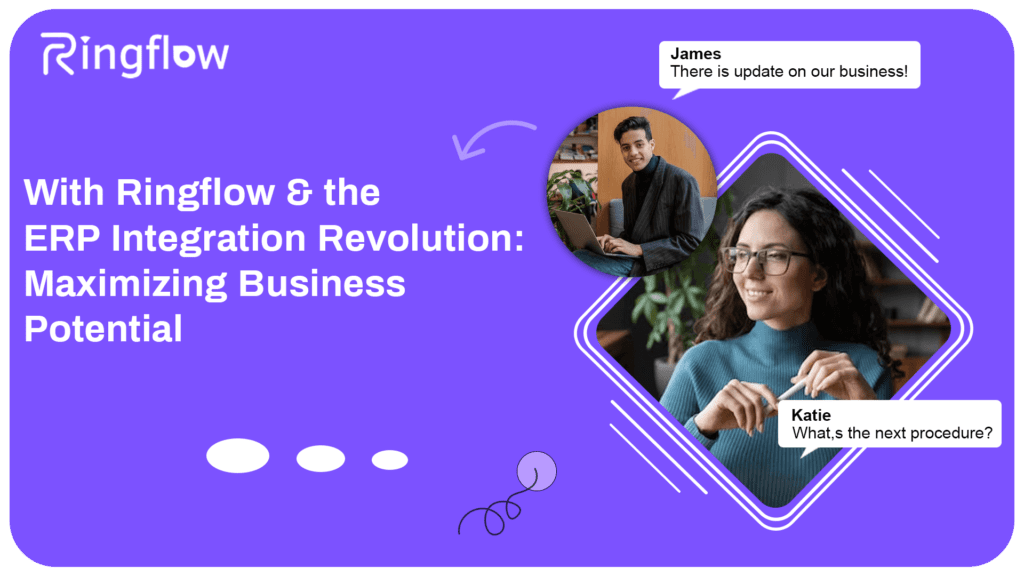Maximizing Business Potential with ERP Integration
Enterprise Resource Planning (ERP) systems have become essential to modern business operations, enabling organizations to automate and optimize various business processes. However, the benefits of ERP systems can be maximized through integration with other systems and applications, both within and outside the organization. This is where ERP integration comes in as a critical aspect of enterprise technology strategy.
Definition of ERP Integration
ERP Integration refers to connecting different enterprise software applications and systems with an ERP system to enable seamless data transfer, collaboration, and automation. This process involves developing connectors or interfaces between two or more distinct software applications, allowing them to communicate with each other through standardized protocols.
ERP integration typically involves integrating different functional areas such as finance, human resources, supply chain management, customer relationship management (CRM), and production planning and control (PPC). By integrating these disparate functions into a single system, such as Ringflow’s ERP system, businesses can achieve greater efficiency in their operations.
Importance of ERP Integration
The importance of ERP integration cannot be overstated. Integrating disparate systems leads to data silos that impede the flow of information across departments or even within a department. This siloed approach can lead to inefficiencies such as data inconsistencies and duplication, weakening decision-making abilities.
ERP integration also enables businesses to leverage existing investments in IT infrastructure by allowing for seamless incorporation into new or updated solutions without disrupting existing operations. It further promotes collaboration across departments by providing real-time visibility into business processes across the enterprise.
Benefits of ERP Integration
ERP integration is one of the most important aspects of maintaining a successful enterprise. It is an advanced process that assists organizations to streamline their businesses and make it more efficient. The benefits of ERP integration with Ringflow are numerous and varied, ranging from improved data accuracy to better decision-making capabilities.
Improved Data Accuracy
One significant benefit of integrating an ERP system like Ringflow is improved data accuracy. Inaccurate data can harm any enterprise by causing disruptions, delays, or even lost revenue.
Having accurate data at your fingertips allows you to make better decisions about your business operations and avoid costly mistakes. Ringflow’s integrated system ensures that all departments within an organization have access to the same up-to-date information, resulting in more reliable forecasting models.
Enhanced Efficiency and Productivity
Another benefit of ERP integration with Ringflow is enhanced efficiency and productivity. With all departments having access to necessary information in real-time, employees can work smarter rather than harder, leading to higher productivity rates. Integrated systems provide automated workflows for routine tasks and eliminate the need for manual processes, significantly reducing processing times.
Integration eliminates downtime related to human error or malfunctioning systems, allowing employees to focus on other important aspects of their job functions, such as customer service. Furthermore, Ringflow’s integrated solution replaces disparate systems where various departments use different applications.
Another benefit of ERP integration with Ringflow is enhanced efficiency and productivity. With all departments having access to necessary information in real-time, employees can work smarter rather than harder, leading to higher productivity rates. Integrated systems provide automated workflows for routine tasks and eliminate the need for manual processes, significantly reducing processing times.
Integration eliminates downtime related to human error or malfunctioning systems, allowing employees to focus on other important aspects of their job functions, such as customer service. Furthermore, Ringflow’s integrated solution replaces disparate systems where various departments use different applications.
Better Decision Making
ERP integration provides better decision-making capabilities by providing real-time insights into different aspects of the business. With all relevant data in one system, decision-makers can quickly evaluate and analyze information to make informed decisions.
In today’s rapidly changing business environments, this capability is essential. Businesses need to adapt quickly to stay ahead of their competitors. ERP integration helps companies achieve this goal by providing accurate information that enables them to respond promptly to changing market conditions.
Streamlined Business Processes
ERP integration streamlines business processes by providing a centralized system capable of handling all critical enterprise functions such as finance, inventory management, sales, procurement, and human resources, among many others. Integration eliminates the need for multiple systems, which saves time and reduces the likelihood of errors or duplication.
Streamlined processes result in more efficient workflows that reduce processing times while saving on associated costs such as staffing overheads. This benefit allows businesses that have integrated their systems with Ringflow’s integrated solution an enormous advantage over their competitors who still rely on outdated manual processes or disparate systems that cause inefficiencies within the organization.
Types of ERP Integration
ERP integration can be categorized into three types; vertical integration, horizontal integration, and data synchronization. Each has different approaches to integrating an ERP system with other organizational applications.
Vertical Integration
Vertical integration is an ERP integration that connects the entire supply chain process from suppliers to customers. It involves the integration of applications that manage processes such as procurement, inventory management, production planning, distribution, and customer relationship management. The aim is to integrate all these processes into a seamless operation to drive efficiency and productivity throughout the supply chain.
One example of vertical ERP integration is connecting an organization’s production planning with its suppliers’ inventory systems so that when inventory levels fall below a certain threshold, the supplier automatically restocks them without human intervention.
Horizontal Integration
Horizontal integration involves integrating different business functions across departments such as finance, marketing, sales, human resources, and production. The goal is to improve department collaboration by sharing data in real-time across different business units. For instance, a horizontal approach to ERP integration can connect an organization’s HR application with payroll processing software or integrate marketing automation software with sales order processing systems for more accurate forecasting.
Data Synchronization
Data synchronization involves synchronizing data across multiple applications in real time so that all the information used by different teams in an organization is up-to-date and accurate. This ensures consistency in data used for decision-making while eliminating errors caused by data entry duplication or outdated information.
For instance, when a new product launch is planned by marketing for sales, order processing teams will have access to this information to adjust their forecasting accordingly. In addition to improving accuracy and efficiency, this type of integration can also reduce the time it takes to share information across different departments.
Strategy for Successful ERP Integration with Ringflow
Define Objectives and Goals
Before integrating an ERP system, defining the objectives and goals you expect to achieve through integration is essential. Start by analyzing your current business processes and identifying areas of improvement.
Determine what you want to achieve from the integration regarding cost savings, increased efficiency, improved data accuracy, better decision-making, or streamlined business processes.
It will also guide your decision-making process when choosing a solution provider. The objectives should be specific, measurable, attainable, relevant, and time-bound (SMART).
Choose the Right Solution Provider
Choosing the right solution provider is critical to achieving a successful integration. Look for providers with experience integrating ERP systems with other business applications like Ringflow. Evaluate their track record with previous clients and check their references carefully.
Consider a provider that offers flexible solutions that can scale up or down as required by your organization’s changing needs. A good provider should also be willing to work closely with your team throughout the entire integration process to ensure all objectives are met on time.
Develop a Comprehensive Plan
The integration plan should include all steps in implementing the ERP system into your IT infrastructure without disrupting ongoing operations. Define roles and responsibilities clearly so that everyone understands their part in the project. A comprehensive plan should include milestones for completing each implementation phase- from planning through testing and training- along with contingency measures for any risks identified during the planning phase.
Testing and Training
Testing is one of the most critical phases of ERP Integration, as it helps identify any errors or bugs before going live. Conduct thorough testing of all system components before launching it fully into production mode. The final step involves training users on the new system.
Ensure that everyone using the ERP system can access proper training and support materials. This can either be in-person or through online platforms.
Data Security Concerns
One of the main concerns with ERP integration using Ringflow is data security. ERP systems often contain sensitive and confidential information, such as financial data, customer information, and proprietary business processes. When integrating with Ringflow, this information may be exposed to external threats such as cyber-attacks or unauthorized access.
It is essential to implement strong security measures throughout the integration process to mitigate these risks. Encryption techniques can be used to protect data during transmission and storage.
User authentication and authorization controls should also be implemented to ensure that only authorized personnel can access sensitive information. Regular security audits should also be conducted to identify vulnerabilities and reinforce best practices.
Compatibility Issues with Legacy Systems
ERP integration with Ringflow can be challenging when dealing with legacy systems that may not be compatible with modern technology standards. Legacy systems may have outdated software or hardware that cannot support newer protocols used by modern ERPs.
To overcome these challenges, businesses must thoroughly assess their existing infrastructure before initiating an integration project. This includes identifying legacy systems that may pose compatibility issues and developing a migration plan to update them where necessary.
It is also important to choose an ERP solution that offers flexible integration options for working with different technologies and platforms. This allows businesses to tailor their integrations based on their unique IT environments while minimizing disruption during implementation.
Cost Implications
ERP integration projects can come at a significant cost due to software licensing fees, hardware upgrades, and IT staff training costs required for successful implementation. Therefore, the cost implications of integrating with Ringflow must be considered when planning the project.
To minimize costs without compromising quality or functionality, businesses must carefully evaluate different ERP solutions before selecting one for integration purposes. An affordable yet comprehensive solution will provide the necessary functionalities while meeting budget constraints.
Moreover, partnering with experienced solution providers can also help reduce costs associated with ERP integration. These providers often have the expertise and resources to streamline the integration process and ensure successful project outcomes.




